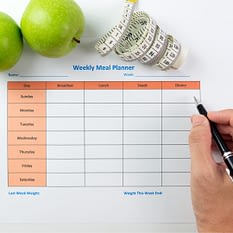Creating Healthy Eating Habits While Working From Home
June 23, 2021 2024-01-03 13:51Creating Healthy Eating Habits While Working From Home

Creating Healthy Eating Habits While Working From Home
More than a year into the pandemic, most of us have adapted to the
new normal of online shopping and speedy supermarket visits. Together, we ate through our pantries, baked sourdough bread, and learned new cooking techniques to cope with the strange new reality happening outside our door. A significant percentage of the workforce was thrust into working from home, some indefinitely. But working remotely does not mimic life in the office, and a year later, many are still struggling to find a healthy balance.
While working from home is beneficial in some ways, it is not without its challenges. Many employees report working longer hours and having less time for grocery shopping and meal preparation. Parents living in communities under shelter-in-place orders juggle work with homeschooling and having a workspace within one’s home means fewer (or no) boundaries, and ultimately less balance.
Nonetheless, some workers are eating better and feeling healthier during the pandemic than they were before. These employees report having lost weight as a result of cooking meals at home and eating less take out, as well as exercising more from home.
 The majority of workers, however, are eating more, exercising less, and gaining weight. In homes that lack a private workspace, some find themselves working from the dining room, steps away from the kitchen with a clear view of the fridge. Frequent video conferences obligate the worker to remain close to the computer, and often the only respite is stepping into the kitchen for a snack or comfort food, especially when they’re feeling frustrated or stressed.
The majority of workers, however, are eating more, exercising less, and gaining weight. In homes that lack a private workspace, some find themselves working from the dining room, steps away from the kitchen with a clear view of the fridge. Frequent video conferences obligate the worker to remain close to the computer, and often the only respite is stepping into the kitchen for a snack or comfort food, especially when they’re feeling frustrated or stressed.
This scenario reflects the data recently published in JAMA, which suggests that Americans gained nearly two pounds a month while under shelter-in-place orders in 2020. Another study published in the Annals of Internal Medicine found that during the initial lockdown, daily step counts decreased by 27 percent. Poor eating habits combined with less movement amounted to a steady weight gain of more than half a pound every 10 days.
At a time when protecting our physical and mental health is most urgent, long sedentary workdays are working against us. More than ever, it is important to prioritize a nutrient-dense diet and balanced lifestyle. What can remote employees do to overcome these challenges?
Create a Daily Eating Strategy
 A good place to start is to have a consistent meal schedule. Eating at the same time each day helps to keep energy levels high throughout long (and often unstimulating) workdays and keep weight under control. Schedule meals and snack breaks right into your calendar.
A good place to start is to have a consistent meal schedule. Eating at the same time each day helps to keep energy levels high throughout long (and often unstimulating) workdays and keep weight under control. Schedule meals and snack breaks right into your calendar.
What you eat is the key to sharpening brainpower. Meals rich in carbs and comfort foods will cause energy levels to wane, affecting concentration. Instead, plan meals around protein, aiming for 20 to 25 grams of protein per meal, and include some protein with each snack.
For many, frequent snacking has replaced a solid lunch meal. To break this habit, a little planning goes a long way. On the weekend, take time to plan lunches for the coming week. Order or pick up groceries, cut up vegetables, and precook ingredients. A fridge filled with ready-to-eat ingredients means lunch can be ready in under 5 minutes.
If you’re seated most of the day, because movement (and calorie burning) is reduced, be mindful of portion sizes. Track your eating by maintaining a daily food diary or with an online app like MyFitnessPal. And if you’re working from the dining room with a full view of the kitchen, turn your chair around to avoid the temptations stashed in the pantry (out of sight out of mind).
The Morning Routine
 What you eat—or don’t eat—in the morning sets the tone for the entire day. Having a significant amount of protein (at least 20 grams) at breakfast helps to stimulate the brain and regulate your appetite throughout the day. Without the rush to get out the door, there is more time to prepare a wholesome breakfast. Some great options are a protein-rich shake or scrambled eggs with diced veggies. For those who prefer a late breakfast or wish to lose weight, intermittent fasting is a good option—delaying eating until noon and concentrating all the day’s calories in an 8-hour period.
What you eat—or don’t eat—in the morning sets the tone for the entire day. Having a significant amount of protein (at least 20 grams) at breakfast helps to stimulate the brain and regulate your appetite throughout the day. Without the rush to get out the door, there is more time to prepare a wholesome breakfast. Some great options are a protein-rich shake or scrambled eggs with diced veggies. For those who prefer a late breakfast or wish to lose weight, intermittent fasting is a good option—delaying eating until noon and concentrating all the day’s calories in an 8-hour period.
Healthy Snacking
Instead of snacking on comfort foods, choose tasty nutrient-dense snacks that deliver some satiating protein and fibre. Top a small bowl of fresh fruit with a quarter cup of kefir or make a trail mix from any crunchy ingredients in your pantry—raw nuts, seeds, coconut chips, dried fruit, a fibre-rich cereal, dry-roasted beans, popcorn, or dark chocolate chips.
Adding Movement
 With gyms closed or at limited capacity, many people are moving much less. A full hour of exercise may not be an option, but exercise doesn’t have to be done all at once. Reaching the goal of 150 minutes of movement per week can be done in short bursts of activity. Set your alarm to take hourly fitness breaks. For 3 to 5 minutes, perform an intense spurt of activity: jumping jacks, squats or jump squats, mountain climbers, or run up and down the stairs. By the end of the day you will have accumulated 15 to 30 minutes of exercise, and a study recently published in the British Medical Journal indicates that short bursts of high-intensity exercise can have even more health benefits than traditional moderate workouts. Exercise throughout the day also contribute to work performance by increasing blood flow to the brain and relieving stress—an important factor in maintaining good mental health.
With gyms closed or at limited capacity, many people are moving much less. A full hour of exercise may not be an option, but exercise doesn’t have to be done all at once. Reaching the goal of 150 minutes of movement per week can be done in short bursts of activity. Set your alarm to take hourly fitness breaks. For 3 to 5 minutes, perform an intense spurt of activity: jumping jacks, squats or jump squats, mountain climbers, or run up and down the stairs. By the end of the day you will have accumulated 15 to 30 minutes of exercise, and a study recently published in the British Medical Journal indicates that short bursts of high-intensity exercise can have even more health benefits than traditional moderate workouts. Exercise throughout the day also contribute to work performance by increasing blood flow to the brain and relieving stress—an important factor in maintaining good mental health.
Lisa Tsakos, R.H.N. is a nationally recognized holistic nutritionist, educator and author specializing in weight management and corporate nutrition programs. Lisa is a co-author of the Natural Nutrition Coach® program.

